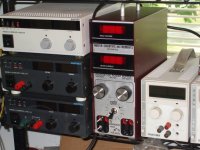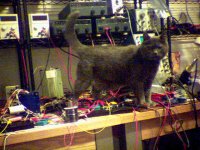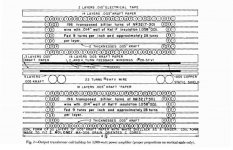Ok, All,
In the process of building a large amplifier... On 0.25" plate steel and forced convection for the tubes (two 4CX250B's and two 4CX1000B's)... The input power supply was a challenge (over one 100mF capacitor at 10KV (rating), something I cannot pick up, and vacuum diodes), with slow-start, I designed and the output will be worse..Help me. I am at a loss for output transformers in this wattage range, 3KV at one ampere can hurt you,.Previously I went with the stack of Crown 2500's, which are so much more realistic, in terms of size, weight... But now I regress to the real tube amplifiers, though I admit the modern ones are superior.
Only for historical purposes, I am purely an amateur here.
--Paul
Note: I am an engineer designing stuff like this for a long time, but I am out-of-practice,
In the process of building a large amplifier... On 0.25" plate steel and forced convection for the tubes (two 4CX250B's and two 4CX1000B's)... The input power supply was a challenge (over one 100mF capacitor at 10KV (rating), something I cannot pick up, and vacuum diodes), with slow-start, I designed and the output will be worse..Help me. I am at a loss for output transformers in this wattage range, 3KV at one ampere can hurt you,.Previously I went with the stack of Crown 2500's, which are so much more realistic, in terms of size, weight... But now I regress to the real tube amplifiers, though I admit the modern ones are superior.
Only for historical purposes, I am purely an amateur here.
--Paul
Note: I am an engineer designing stuff like this for a long time, but I am out-of-practice,
Last edited:
Hi Paul,
Would you be able to point to a doc detailing the design of the power supply that you have designed so far for your target amp? It sounds like you have settled on a lot of amplifier operating conditions and performance levels and protection mechanisms ?
Would you be able to point to a doc detailing the design of the power supply that you have designed so far for your target amp? It sounds like you have settled on a lot of amplifier operating conditions and performance levels and protection mechanisms ?
I am at a loss for output transformers in this wattage range
Any OPT in the 500+ watt range will likely be a custom job built to spec by a reputable transformer winder. It may be possible to use a modulation transformer from a vintage transmitter followed by a suitable impedance matching transformer, but the frequency response will be limited.
The input power supply was a challenge.....the output will be worse......two 4CX250B's and two 4CX1000B's.......3KV at one ampere.....I am an engineer designing stuff like this
There is conflicting and incomplete information here. It is not clear what you want to do other than build a really big amp.
A pair of 4CX250's can put out 600 watts. A pair of 4CX1000's nearly 4 KW. Is this a bi-amped system, with two separate power amps? You mention 3KV at 1A, that's 3 KW of power supply. Assuming 50 to 60% plate efficiency you are looking at 1500 to 1800 watt amp.
The success rate for an amp of this magnitude is very low for most builders. The voltages, currents and dollars involved make the cost of failure quite steep. In order to minimize the risks, I would advise outlining exactly what you want to do, and how you plan to get there. Draw up a block diagram, and maybe preliminary schematics of each block, identify the key elements of the design that are not "off the shelf" parts (like the transformers) and create a spec sheet for each unique component, then see if you can actually buy it, or get it made somewhere.
There have been several "big amp" designs discussed on this forum, but few actually become working amps. If you intend to seek help here or on any other forum, it would help to for up to know exactly what you want to do. A well drawn up "plan of attack" will improve your chance of success too.
The best success story is here:
http://www.diyaudio.com/forums/tube...-crisis-my-833c-amp-build.html?highlight=833A
There was a long thread here where a builder in Italy (I think) set out to design a big amp with transmitter tubes several years ago. He had a well conceived plan and had drawn up specs for OPT's which he had custom built by a vendor who built transformers, but not tube OPT's specifically. His amp got built, but one OPT burst into flames as the amp was first tested (while music was actually playing). We never saw the conclusion of the thread since the builder disappeared. I believe that his OPT supplier did not understand the voltages involved and did not properly insulate it.
My "big one" will be approximately 1KW. A stereo amp of 500 watts per channel. At the usual efficiency, this is the maximum power output that can be supplied by a typical US spec AC power outlet (120 volts, 15 amps). Haven't had the time to build it yet, and some more testing will be needed before my plan is finalized.
AR
REFERENCE 750 SE
Seems logical and better option to // many tubes than go to transmission tubes
REFERENCE 750 SE
Seems logical and better option to // many tubes than go to transmission tubes
Thinking too loud:
To couple 3,360 Watts from 3,450 Ohms to 8 Ohms is 3,405V:164V. As a hasty test hack you can use a power transformer. PTs are not designed for low THD so to approach 50Hz you should de-rate considerable. 6,600V:318V is a start. The primary voltage is (was?) a standard pole-pig transformer voltage. 318V not a standard value. For bench-tests you can acquire a 6.6KV:240V and work it to a 4.5 Ohm dummy load (or 4 Ohms of large speakers).
I have looked into this (for house-power, not audio). Kilo-Watt iron does not sell cheap, then shipping is monstrous.
Audio winding experts do not have the heavy hoists to work on kiloWatt cores. Power transformer specialists are used to techniques to reduce arc-over, which is bad for audio treble.
When you self-learn enough about audio transformers, go to India. They wind power transformers (all sizes) in sheds by hand. Negotiate a pound-price and an hour-price, then supervise it yourself.
To couple 3,360 Watts from 3,450 Ohms to 8 Ohms is 3,405V:164V. As a hasty test hack you can use a power transformer. PTs are not designed for low THD so to approach 50Hz you should de-rate considerable. 6,600V:318V is a start. The primary voltage is (was?) a standard pole-pig transformer voltage. 318V not a standard value. For bench-tests you can acquire a 6.6KV:240V and work it to a 4.5 Ohm dummy load (or 4 Ohms of large speakers).
I have looked into this (for house-power, not audio). Kilo-Watt iron does not sell cheap, then shipping is monstrous.
Audio winding experts do not have the heavy hoists to work on kiloWatt cores. Power transformer specialists are used to techniques to reduce arc-over, which is bad for audio treble.
When you self-learn enough about audio transformers, go to India. They wind power transformers (all sizes) in sheds by hand. Negotiate a pound-price and an hour-price, then supervise it yourself.
d class in new ss circuit can deliver more than 1000 watt .but tubes can make more .in big power quality will .change.
Power transformer specialists are used to techniques to reduce arc-over, which is bad for audio treble.
Power transformer specialists are not aware of the peak voltages involved in an audio amplifier that is driving a reactive load like a speaker.
It is not uncommon for the peak voltage to reach 2X to 3X the B+ voltage when driving a speaker in the bass resonance region when the amp is NOT pushed into hard clipping ( a HiFi application). I have measured over 2KV in a guitar amp with a 430 volt B+ that was driven about 10 db beyond the clipping point. The resonance of most guitar speakers is within the guitar's operating frequency range leading to all sorts of reactive resonant voltage excursions.
The OPT must be designed to eat voltage peaks that are as much as 5X the B+ voltages, or devices to clamp the peak voltages must be used. These devices DO create audible artifacts when activated, but this is often preferred to a fireball in the OPT!
Note: once an arc starts in an OPT it will be fed by the B+ until the current is interrupted by a fuse or other component failure. I managed to set an OPT on fire on my workbench when my undersized load resistor failed to an open during a full power test on a 150 watt sweep tube amp.
Such flaming failures were common on 1st generation Ampeg SVT bass guitar amps (400 watts from 6 X 6146 transmitter tubes). Ampeg redesigned the amp to use 6550's and the failures were reduced. I witnessed one 6550 based amp blowing up at an outdoor rock concert in the early 70's. I could hear the characteristic rattling sound of a speaker's voice coil melting down. The speaker (1 of 8) eventually failed to an open, placing more power on the other 6, causing more failures leading to an amp with no load running at full crank. Flames shot out of the back of the amp.
In a weird twist of fate, I wound up fixing the amp after ACE Music in Miami said that it was not repairable. Ampeg cut us a break on the parts cost, but the OPT, power transformer, several tubes, a couple of tube sockets, and some other small parts were all fried......this was from about 600 volts of B+.
Note, This is the biggest high quality commercial tube OPT that I know of, about $400 USD each for 400 watts. I have two sets of similar Plitron OPT's that were sold through their surplus page several years ago. I have seen 525 watts flow through one of them, so that's what I will be using. Feed them about 600 volts and use 4 really big sweep tubes, or 6 big sweep tubes to get 500 watts per channel. Anything bigger will require a special OPT.
https://shop.plitron.com/specs/414100.pdf
Last edited:
As a practical matter, building several smaller amplifiers will provide a still working system if one of them unexpectedly fails. Not to mention off the shelf OTs, power Xfmrs, and quantity pricing. And safer B+.
We haven't heard what this amplifier is being used for. If it has to be moved around, then light weight switching power supplies will be far more practical at 600V than at 3000V. One could even go so far as to use switch-mode (David Berning like) OTs. Then the tube amps could weigh nearly the same as the Crown amps.
Pic below:
3 Kilowatts of off the shelf switch-mode 600V power (stacked up on the left).
Even the cat is bigger.
We haven't heard what this amplifier is being used for. If it has to be moved around, then light weight switching power supplies will be far more practical at 600V than at 3000V. One could even go so far as to use switch-mode (David Berning like) OTs. Then the tube amps could weigh nearly the same as the Crown amps.
Pic below:
3 Kilowatts of off the shelf switch-mode 600V power (stacked up on the left).
Even the cat is bigger.
Attachments
Last edited:
https://www.youtube.com/watch?v=G7qMVYf85sM schematics are available; this one is AB2
https://frank.pocnet.net/sheets/030/q/QB3.5-750.pdf
https://frank.pocnet.net/sheets/030/q/QB3.5-750.pdf
With due respect, the OP project sounds like a dream, doubly so coming from somebody who has not built *standard* high power amps, let alone this monstrosity.
this is a Bereskin 3kW power amp.....http://www.tubebooks.org/file_downloads/bereskin_3kw.pdf
Attachments
I started looking at A Big One a while back. Class A, PP GU-81m...to deliver about 300W. No OPT that big will have low enough leakage L and winding capacitance, not to mention core misbhaviour to work well at 3-10 Watts which is where it would probably usually live.
Good OPT's are limited to about 70-80W, and even the best are probably less good around a Watt than a 40W one...🙂 So I build 50-60W, single pair Class A amps. The latest of which will be cathode driven HY51A. A small driver amp, with an IT/OPT to go from the mid-stage power tubes to 500R split CT secondary. If I need more than three like this, I'll probably be too deaf to care anyway...LOL
cheers,
Douglas
Good OPT's are limited to about 70-80W, and even the best are probably less good around a Watt than a 40W one...🙂 So I build 50-60W, single pair Class A amps. The latest of which will be cathode driven HY51A. A small driver amp, with an IT/OPT to go from the mid-stage power tubes to 500R split CT secondary. If I need more than three like this, I'll probably be too deaf to care anyway...LOL
cheers,
Douglas
hpeter, that video of the 1000W amp playing Bach Toccta D-Moll is amazing. I just ordered a CD with that recording put out by Deutsche Grammphon. I don't think it is going to sound the same on MC40 monoblocks and Altecs though.
That amp looks down right frightening with all the ps tubes pulsing to the music and that meter almost pegging itself. Not sure that I want that monster in my living room.
BillWojo
That amp looks down right frightening with all the ps tubes pulsing to the music and that meter almost pegging itself. Not sure that I want that monster in my living room.
BillWojo
Pssstttt !!!! guys !!!!! this thread is about 3 to 5kW amps, 5kV supplies and truck engine block size (and weight) transformers.
Keep your puny 600V 300W amps in the playpen at the nursery 😉
Only a couple brave souls stayed focused .
Keep your puny 600V 300W amps in the playpen at the nursery 😉
Only a couple brave souls stayed focused .
Umm, Power = Volts x Current
last time I heard.
Nothing really wrong with 600V, but I can see I'm on the wrong groove here.
But if someone wants truck size engines, then just audio modulate the field winding on a big truck alternator. In fact, use two alternators and modulate them in complementary fashion to get + and - P-P totem pole output. Or, put them in series for Circlotron output.
last time I heard.
Nothing really wrong with 600V, but I can see I'm on the wrong groove here.
But if someone wants truck size engines, then just audio modulate the field winding on a big truck alternator. In fact, use two alternators and modulate them in complementary fashion to get + and - P-P totem pole output. Or, put them in series for Circlotron output.
Last edited:
You will need forced air on the 4CX250B and the 4CX1000A at any power level! This means the Eimac type air sockets for both tube types. Muffin fans won't work. One way is to pressurize the chassis and the air goes up past the socket and through the finned radiator.... Be careful, the HT voltages are dangerous! I'm sure you're aware the finned radiator is at full HT potential. I have worked with these tubes in FM transmitters. Put plenty of air through them and they will last. Watch the screen voltage/current also; don't over dissipate the screen; this will shorten the life of the tube considerably.Ok, All,
In the process of building a large amplifier... On 0.25" plate steel and forced convection for the tubes (two 4CX250B's and two 4CX1000B's)... The input power supply was a challenge (over one 100mF capacitor at 10KV (rating), something I cannot pick up, and vacuum diodes), with slow-start, I designed and the output will be worse..Help me. I am at a loss for output transformers in this wattage range, 3KV at one ampere can hurt you,.Previously I went with the stack of Crown 2500's, which are so much more realistic, in terms of size, weight... But now I regress to the real tube amplifiers, though I admit the modern ones are superior.
Only for historical purposes, I am purely an amateur here.
--Paul
Note: I am an engineer designing stuff like this for a long time, but I am out-of-practice,
this is a Bereskin 3kW power amp.....http://www.tubebooks.org/file_downloads/bereskin_3kw.pdf
Hi Tony,
have you as a transformer winding expert ever tried to wind one according to this or another Bereskin scheme? I'm in doubt that it is useful, or even possible, to swap both bifilar wires after each turn to achieve transposing.
Best regards!
Hi Tony,
have you as a transformer winding expert ever tried to wind one according to this or another Bereskin scheme? I'm in doubt that it is useful, or even possible, to swap both bifilar wires after each turn to achieve transposing.
Best regards!
not an expert, and no, but i have been looking at this for years,.....
i think the transposition happens at the corners, on one corner...
tbh, i have not done anything like it, although i have done bifilar winds...
- Home
- Amplifiers
- Tubes / Valves
- I hope this is the right forum... big amp with output xformers



